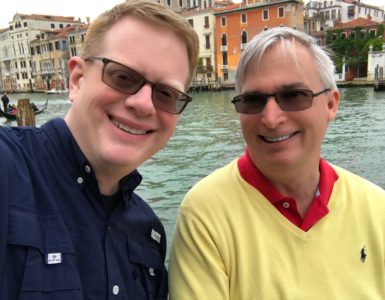Planet Coke
At the World of Coke, a multi-ton version of the familiar trademark floats above our heads, spinning like a steel and neon Oribitron. Beneath its flickering warmth, we participate in a advertiser’s wet dream: here, the consumers not only pay to see advertising … they pay to be advertising, plunking down cash for the right to bear on their bodies the mark of a corporate beast.
Inside, we wander like dazed cattle from exhibit to exhibit. The video displays, concealed in giant cola cans, prattle on for too long about the glories of Coke — not even the interactive touch screens entice visitors to linger for more than a few seconds.
A glance at our map reveals we’re just steps away from the next feature: a life-size recreation of a 1950’s drug store soda fountain. In the photo, a handsome young soda jerk tells a smiling modern family about the days when Cokes were drawn fresh from the tap … but when our turn in the geniune simulated replica rolls around, a bored Coke employee in his late thirties glares at us from behind the counter and says, “This is just to show you what it was like.”
In the large-screen video theater, we spend twenty minutes in semi-darkness while an enthusiastic company president assures us that, right this second, around the globe, hundreds of people “enhance their lives” with Coke. To drive the point home, we see Coke ending an African shepherd’s day, reuniting a lost child with his father, and chasing a frown from a Korean businessman’s face.
Warring street gangs would embrace, the video implies, if they met in the glow of a Coke machine. All peoples unite in the perfection of the World of Coke; no one is hungry (or thirsty), poor, maimed, handicapped, diseased … or, judging from the repeated images of happy heterosexual couples in the film, gay.
The exhibit shouts its message again and again: Coke no longer adds life … Coke is life. It’s bliss in a bottle, a sticky black beverage binding all earthlings together. After the first few minutes, I put an arm around Clyde and we both doze, lulled to sleep by the aggressive air-conditioning, until the lights come up. I dream of a parade of gays and lesbians, linked arm in arm with their straight brothers and sisters, carrying red and white cans in upraised hands, singing, “I’d Like to Teach the World to Sing.”
From there, the flow of traffic carris us to our ultimate destination: the tasting room. First, flashing and mysterious man-sized fountains ejaculate samples of familiar Coke products/ They spurt parabolas of sticky fluid into air; we catch them in our cups. We wait in line to try Coke II, which turns out to be proof that no sequel can ever compare to the original.
The next room, however, draws a much larger crowd. A group of mostly unused cafe tables cluster beneath futuristic white video monitos, each of which plays endless loops of “favorite Coke ads, past and present.” (Do people really have “favorite Coke ads?”)
Around the room’s perimeter, multitudes of noisy children clamor for a turn at dispensers of Fanta Beverages of Many Nations. They push and shove their way to the spigots, indiscriminately sampling every conceivable flavor, from licorices to florals. Many, intent on concocting the ultimate Fanta cocktail, mix all forty flavors into one sticky-sweet froth. Child after child accomplishes this goal, sips the result, winces, and pours the rest of the brew in the trash.
Unable to resist, we force our way to the front of the line, cups outstretched. We struggle from flavor to flavor, using our superior height to gain an advantage over the children, who glare up at us in open resentment. We are lost in a fantasy of cost-free consumption, rates who have wandered the maze and now fight to press the bars, never satisfied, always wanting more.
An aggressive pack of children come between me and Mango Fanta, pressing their short bodies close together, filling cup after cup. No amount of pressure moves them to one side. I am possessed with a conviction: Mango Fanta, an exotic beverage bottled only in South America, is destined to be my drink of choice. I imagine importing it, serving it stingily to friends I judge Mango-worthy.
Each time I lunge for the spigot, the children knock my cup away.
Finally, a thin young man in official Coke garb, his hands too large for his skinny wrists, his hair too neatly kept, and his gaze a bit too wet and lingering, moves into the fray. “Move back,” he says, his voice like soft velvet. “Move back, kids. Let everybody get some.” He glances at me and smiles. “Get a little, drink a little, and you can come back for more.”
The kids respond to his motherly presence. He squeezes my shoulder as he drifts past. It seems there are gay people in the World of Coke after all … recognizing and taking care of their own.
I draw a drink for Clyde and for me. Clyde turns his down; merely standing under a mango tree is enough to make him break out in hives. Cautiously, I take a sip. Mango Fanta, it turns out, is very sweet, very watery. The flavor lingers, and I find myself craving a real Coke to wash the aftertaste away.
“How clever,” Clyde points out. “There’s no real Coke in this room.”
I leave the tasting gallery with Clyde in tow, determined to find and buy one.


Add comment